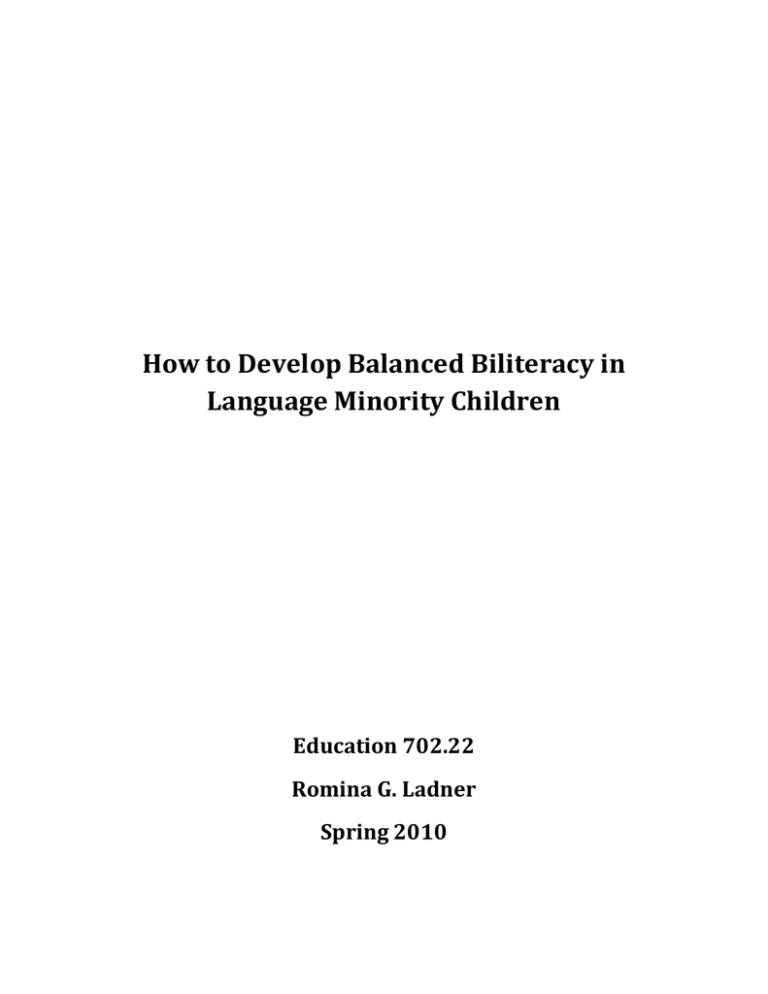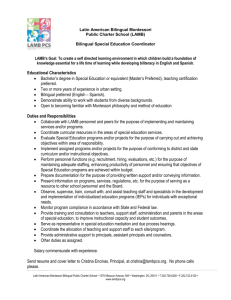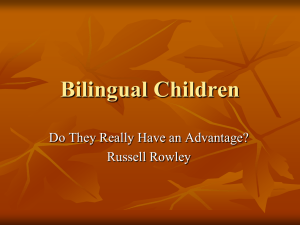Final Action Research Paper
advertisement

How to Develop Balanced Biliteracy in Language Minority Children Education 702.22 Romina G. Ladner Spring 2010 Table of Contents Abstract 2 Introduction 3 Statement of the Problem 4 Review of Related Literature 5-9 Statement of the Hypothesis 10 Method 11 Participants 11 Instruments 11 Experimental Design 11 Procedure 11 Results Discussion Implications References 12-13 Appendix 14 Abstract Introduction Through the years, the coexistence of different cultures has formed what we call today a multicultural society. In these multicultural societies, bilingualism is a rule and not an exception. Language has been a determining factor in the history of industrialized countries and developing countries. Language, literacy, and power are closely tied. Therefore, it is evident that language plays a fundamental role in children’s literacy. To learn English and to maintain proficiency in Spanish are great advantages of our Latino culture. Our schools and classrooms reflect a multicultural society where most language minority children face the problem of losing their linguistic and cultural identity. By the end of elementary school, most language minority students do not posses balanced biliteracy. For this reason, it is necessary to look for new theoretical and practical strategies to help language minority students to reach and maintain literacy in both languages. The purpose of this action research is to find out why minority language student do not develop both languages equally and what strategies can be used to help minority language students to reach biliteracy. Statement of the Problem The coexistence of different cultures has formed what we call today a multicultural society. In this society, bilingualism is a rule and not an exception. Our schools and classrooms reflect this multicultural society where most language minority students face the problem of losing their linguistic and cultural identity in the process of acquiring a second language. By the end of elementary school, most language minority students do not posses balanced biliteracy. Review of Related Literature Articles on Bilingual Program Effectiveness: Baker, C. (2006). Education for bilingualism and biliteracy. In Foundations of bilingual education and Bilingualism (11, pp 228-258). The author states that within the ten varieties of bilingual education there are “strong” forms of bilingual education that foster both languages in the curriculum. The main objective of these strong forms of bilingual education is to prepare students to be bilingual, biliterate, and bicultural. The outcomes of these forms of bilingual education vary in the amount of time given to the minority and majority languages. Collier, V. (1989). A Synthesis of studies examining long-term language minority student data on academic achievement. From: http://scholar.google.com/scholar?hl=en&as_sdt=20000000000&q=academic+achieve ment+bilingual+classes+collier+v+1989 The author presents findings about language-minority students’ academic achievement throughout a four year long research in comparison with the longitudinal findings on students’ academic achievement reported by the Ramirez study. The findings support that the greater amount of L1 instruction, combined with balanced L2 instruction, provides language-minority students the opportunity to achieve higher academic levels. Cummins, J. (1992). Bilingual education and English immersion: The Ramirez report in theoretical perspective. Bilingual Research Journal, 16: 1&2, 91-104. The article refers to the findings of The Ramirez Report which states that Latino students have better academic result when using L1 as a medium of instruction. It also explains the different theories and the implication of the report. Goldenberg, C. (Summer 2008). Teaching English language learners: What the research does and does not- say. American Educator, 8-23. The article reviews some research on bilingual education and some instructional modifications. Milk, R., Mercado, C., & Sapiens, A. (1992). Re-thinking the education of teachers of language Minority children: developing reflective teachers for changing schools. NCBE Focus: Occasional Papers in Bilingual Education, Number 6. The article refers to up-date teacher training and development programs; and it also refers to the importance of preparing teachers to be reflective teachers for different classroom contexts. Thomas, W. P., Collier, V. P. (1997). School effectiveness for language minority students. NCBE Resource Collection Series, No. 9. December, 1997. ERIC # ED436087, from: http://eric.ed.gov/ERICWebPortal/custom/portlets/recordDetails/detailmini.jsp?_nfpb=tru e&_&ERICExtSearch_SearchValue_0=ED436087&ERICExtSearch_SearchType_0=no&accno= ED436087 This paper presents the findings from different schools about long-term student achievement as a result of a variety of instructional practices. Articles on Different Instructional Approaches: Ada, A. F. (1976). Desarrollo lingüístico y vivencia cultural a través de la literatura infantil. [Language development and cultural awareness through children's literature] Journal of the National Association for Bilingual Education, 1, 1, 65-71, May 76. ERIC # EJ136628, from: http://www.eric.ed.gov/ERICWebPortal/custom/portlets/recordDetails/detailmini.jsp?_ nfpb=true&_&ERICExtSearch_SearchValue_0=EJ136628&ERICExtSearch_SearchType_0= no&accno=EJ136628 The author stresses the importance of children’s heritage and language in order to amplify children’s vocabulary and bring new linguistic patterns into the process of language learning. The author provides us with ideas for integrating language minority children’s literature in the classroom. The article is written in Spanish. Dworin, J.E. (2003). Insights into biliteracy development: Toward a bidirectional theory of Bilingual pedagogy. Journal of Hispanic Higher Education, Vol. 2, No. 2, 171-186 The main focus of this article is on recent theoretical perspectives on biliteracy and the development of bilingual pedagogy. Ernst-Slavit, G., & Mulhern, M. (2003) Bilingual books: Promoting literacy and biliteracy in the Second language and mainstream classroom. From Reading online http://www.readingonline.org/articles/art_index.asp?HREF=ernst-slavit/index.html This article discusses the benefits of using bilingual books in the classroom and strategies that can be use to help students to acquire literacy. Griego-Jones, T. (1994). Assessing student’s perceptions of biliteracy in two way bilingual classroom. The Journal of Educational Issues of Language Minority Students, v. 13, 79-93. The author states that the role of children’s attitudes in learning how to read and write has not been taken into consideration in different research. Attitude and motivation are critical factors at the time of acquiring a new language. Hornbergen, N.H. (2002). Multilingual language policies and the continua of biliteracy: An ecological approach. Language Policy, v1 n1. The paper focuses on multilingual language policies and how the classroom and community face the challenges of the ecological approach. Morales-Nadal, M. (1988-1990) “Literature and the language minority child: A multicultural perspective.” In Ambert, A. (Ed.), Bilingual Education and English as a Second Language: A Research Handbook. Publisher: Garland Pub., 1991. Milga Morales-Nadal is Assistant Professor of Education at Brooklyn College at CUNY, and supervisor of the students in the department’s Bilingual Teacher Education Program. Prof. Morales-Nadal has presented papers on researches that involved different approaches to inclusive and multicultural education, bilingual education, and cultural and linguistic factors in assessing students in ESL programs. In this article, she addresses the importance of using different approaches to increase language competence and also the importance of multicultural literature to empower language minority students through meaningful literature. Ruiz, R. (1984). Orientations in language planning. NABE: The Journal for the National Association for Bilingual Education, v8 n2 p15-34 Win 1984. ERIC # EJ307292, from: http://eric.ed.gov/ERICWebPortal/custom/portlets/recordDetails/detailmini.jsp?_nfpb= true&&ERICExtSearch_SearchValue_0=EJ307292&ERICExtSearch_SearchType_0=no&ac cno=EJ307292 The author mentions three orientations toward language and its role in society: language-asproblem, language-as-right, and language-as-resource. The author states that it is important to develop and elaborate a language-resource orientation to integrate bilingual education into a responsible language policy. Upczak Garcia, A. (2008 a). Bilingual identities for ELLs: How to work with culturally and Linguistically diverse learners. From: http://esllanguageschools.suite101.com/article.cfm/bilingual_identities_for_ells This article stresses the value of bilingualism as a medium to develop biliteracy. Upczak Garcia, A. (2008 b). Creating space to be bilingual: Why separate language environments may not be the answer. From: http://esllanguageschools.suite101.com/article.cfm/creating_space_to_be_bilingual This article refers to students that live in two different worlds: one at home and one at school. They use different language in each setting and the question of the article is why teachers can’t provide a setting where students can use both languages and practice how to switch from one language to the other. Zehler, A. (1994). Working with English language Learners: Strategies for elementary and middle school teachers. NCBE Program Information Guide Series, Number 19. This article provides different strategies to work with English language learners. Articles on Biliteracy and Empowerment: Ada, A. F. (1992). Biliteracy for personal growth and social participation. In Pérez,B., & Torres Guzmán, M. (Ed.), Learning in two worlds: An integrated Spanish/English biliteracy approach. New York: Longman, xi-xiii. Alma Flor Ada is a professor Emerita at the University of San Francisco, an advocate of bilingual education. She is the author of more than 200 books for children, young readers, adult novels and educational materials. She has been recognized as a leading mentor in Transformative Education. In this article, she refers to the oppression of the native language and culture in many different schools and the importance of maintaining cultural identification in order to gain social representation and power. She also mentions how to organize the curriculum and the learning environment in order to facilitate growth in literacy in both Spanish and English. Cummins, J. (1986). Empowering minority students: A framework for intervention. Harvard Education Review (56, pp 18-36). The author presents a framework for empowering minority students through cultural/linguistic incorporation, community participation, pedagogy and assessment. Cummins, J. (1999-2003). Biliteracy, empowerment, and transformative pedagogy. From: I Teach I Learn http://www.iteachilearn.com/cummins/biliteratempowerment.html This paper argues about how essential an educational reform to help under-achieving Latin@ students is. In the absence of biliteracy students are unable to read the word or the world in their two languages. Freeman, Y.S., Freeman, D.E., & Mercuri, S. P. (2005) Dual Language essentials for teachers and administrators. From Heinemann College http://college.heinemann.com/shared/onlineresources/E00653/chapter2.pdf The article focuses on how important is that teachers and administrators support dual language education in order to contribute to the preparation of students as learners and citizens in this diverse society. Articles on Bilingual Education Controversy: Williams, M. (2009). U.S. Bilingual education controversy continues: Teach ESL students in Native languages or through English immersion? From: http://esllanguageschools.suite101.com/article.cfm/us_bilingual_education_controvers y_continues The article states that the controversy over bilingual education focuses on whether it is effective or desirable for ELL to be taught in their native language or whether they should be taught in English. Rothstein, R. (1998). Bilingual education: The controversy. Phi Delta Kappan, Vol. 79. The author states that bilingual education is not only balkanizing American melting pot but also hurting children by leaving them unprepared for the workplace. Anderson, L. (2001). Critics say bilingual education programs put students at disadvantage. Knight Ridder/Tribune News Service. The article states that bilingual education has become a national debate within politicians, immigration officials and educators. There are many states that support and try to improve bilingual education, and there are others that consider banning bilingual education. The main point is that parents and educators critic bilingual education and think is a disadvantage for students. Valdes, G. (1997). Dual-language immersion programs: A cautionary note concerning the education of language- minority students. Harvard Educational Review, vol. 67, n 3, 391-430. The author writes about the negative effects of the dual-language immersion movement. Some of the issues that she states that affect language-minority students are: the quality of instruction in the minority language, the effects of dual immersion on intergroup relations, how dual-language immersion programs fit into the relationship between language and power and how that relationship may affect the children and society. Moran, R.F. (1987). Bilingual education as a status conflict. California Law Review, Vol. 75, No.1, Seventy-Fifth Anniversary Issue, 321-362. This paper uses status conflict analysis to describe how participant in the bilingual education controversy have used language as a medium to defend their culture, customs, and values. Statement of the Hypothesis HR 1: To implement a bilingual reading program over 8 weeks for 45 minutes 4 days a week to 21 third graders will increase their reading scores in both English and Spanish. Method Participants: The participants are 21 third- grade students from a dual language classroom in PS X. Instruments: Consents, Observations, Interviews, Reading Lesson Plans, Running Records, Reading Level Charts, and Informal Assessments. Experimental Design: Procedures: Results Discussion Implications References Ada, A. F. (1976). Desarrollo lingüístico y vivencia cultural a través de la literatura infantil. [Language development and cultural awareness through children's literature] Journal of the National Association for Bilingual Education, 1, 1, 65-71, May 76. ERIC # EJ136628, from http://www.eric.ed.gov/ERICWebPortal/custom/portlets/recordDetails/detailmini.jsp?_nfpb=tr ue&_&ERICExtSearch_SearchValue_0=EJ136628&ERICExtSearch_SearchType_0=no&accno=EJ13 6628 Ada, A. F. (1992). Biliteracy for personal growth and social participation. In Pérez,B., & TorresGuzmán, M. (Ed.), Learning in two worlds: An integrated Spanish/English biliteracy approach. New York: Longman, xi-xiii. Anderson, L. (2001). Critics say bilingual education programs put students at disadvantage. Knight Ridder/Tribune News Service. Baker, C. (2006). Education for bilingualism and biliteracy. In Foundations of bilingual education and Bilingualism (11, pp 228-258). Collier, V. (1989). A Synthesis of studies examining long-term language minority student data on academic achievement. From http://scholar.google.com/scholar?hl=en&as_sdt=20000000000&q=academic+achievement+bili ngual+classes+collier+v+1989 Cummins, J. (1986) Empowering minority students: A framework for intervention. Harvard Education Review (56, pp 18-36) Cummins, J. (1992). Bilingual education and English immersion: The Ramirez report in theoretical perspective. Bilingual Research Journal, 16: 1&2, 91-104. Cummins, J. (1999-2003) Biliteracy, empowerment, and transformative pedagogy. From: I Teach I Learn http://www.iteachilearn.com/cummins/biliteratempowerment.html Dworin, J.E. (2003). Insights into biliteracy development: Toward a bidirectional theory of bilingual pedagogy. Journal of Hispanic Higher Education, Vol. 2, No. 2, 171-186 Ernst-Slavit, G., & Mulhern, M. (2003) Bilingual books: Promoting literacy and biliteracy in the second-language and mainstream classroom. From Reading Online http://www.readingonline.org/articles/art_index.asp?HREF=ernst-slavit/index.html Freeman, Y.S., Freeman, D.E., & Mercuri, S. P. (2005) Dual Language essentials for teachers and administrators. From Heinemann College http://college.heinemann.com/shared/onlineresources/E00653/chapter2.pdf Goldenberg, C. (Summer 2008). Teaching English language learners: What the research does-and does not- say. American Educator, 8-23. Griego-Jones, T. (1994). Assessing student’s perceptions of biliteracy in two way bilingual classroom. The Journal of Educational Issues of Language Minority Students, v. 13, 79-93. Hornbergen, N.H. (2002). Multilingual language policies and the continua of biliteracy: An ecological approach. Language Policy, v1 n1. Milk, R., Mercado, C., & Sapiens, A. (1992). Re-thinking the education of teachers of language minority children: developing reflective teachers for changing schools. NCBE Focus: Occasional Papers in Bilingual Education, Number 6. Morales-Nadal, M. (1988-1990) “Literature and the language minority child: A multicultural perspective.” In Ambert, A. (Ed.), Bilingual Education and English as a Second Language: A Research Handbook. Publisher: Garland Pub., 1991. Moran, R.F. (1987). Bilingual education as a status conflict. California Law Review, Vol. 75, No. 1, Seventy-Fifth Anniversary Issue, 321-362. Ruiz, R. (1984). Orientations in language Planning. NABE: The Journal for the National Association for Bilingual Education, v8 n2 p15-34 Win 1984. ERIC # EJ307292, from http://eric.ed.gov/ERICWebPortal/custom/portlets/recordDetails/detailmini.jsp?_nfpb=true&_ &ERICExtSearch_SearchValue_0=EJ307292&ERICExtSearch_SearchType_0=no&accno=EJ307292 Rothstein, R. (1998). Bilingual education: The controversy. Phi Delta Kappan, Vol. 79. Thomas, W. P., Collier, V. P. (1997). School effectiveness for language minority students. NCBE Resource Collection Series, No. 9. December, 1997. ERIC # ED436087, from http://eric.ed.gov/ERICWebPortal/custom/portlets/recordDetails/detailmini.jsp?_nfpb=true&_ &ERICExtSearch_SearchValue_0=ED436087&ERICExtSearch_SearchType_0=no&accno=ED43608 7 Upczak Garcia, A. (2008 a). Bilingual identities for ELLs: How to work with culturally and linguistically diverse learners. From: http://esllanguageschools.suite101.com/article.cfm/bilingual_identities_for_ells Upczak Garcia, A. (2008 b). Creating space to be bilingual: Why separate language environments may not be the answer. From: http://esllanguageschools.suite101.com/article.cfm/creating_space_to_be_bilingual Valdes, G. (1997). Dual-language immersion programs: A cautionary note concerning the education of language- minority students. Harvard Educational Review, vol. 67, n 3, 391-430. Williams, M. (2009). U.S. Bilingual education controversy continues: Teach ESL students in native languages or through English immersion? From: http://esllanguageschools.suite101.com/article.cfm/us_bilingual_education_controversy_contin ues Zehler, A. (1994). Working with English language Learners: Strategies for elementary and middle school teachers. NCBE Program Information Guide Series, Number 19. Appendix English and Spanish Reading Levels Spring 2009: 4.5 4 3.5 3 2.5 2 1.5 1 0.5 0 Students' English Reading Levels Students' Spanish Reading Level








